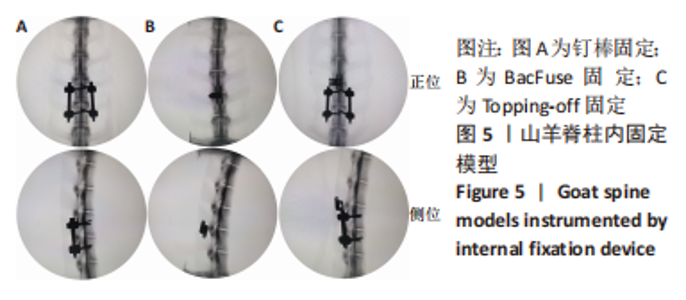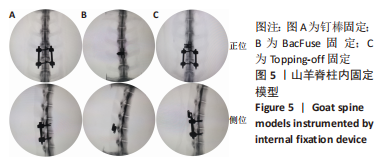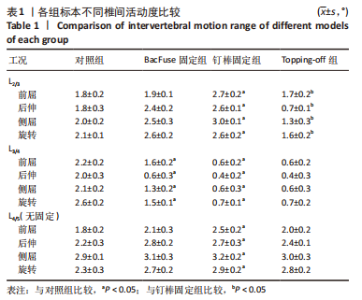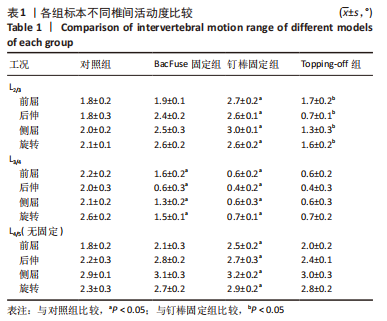Chinese Journal of Tissue Engineering Research ›› 2024, Vol. 28 ›› Issue (9): 1325-1329.doi: 10.12307/2023.912
Previous Articles Next Articles
Biomechanical characteristics of a novel interspinous distraction fusion device BacFuse for the repair of lumbar degenerative disease
Chen Mengmeng, Bao Li, Chen Hao, Jia Pu, Feng Fei, Shi Guan, Tang Hai
- Beijing Friendship Hospital, Capital Medical University, Beijing 100050, China
-
Received:2022-12-23Accepted:2023-02-08Online:2024-03-28Published:2023-07-25 -
Contact:Tang Hai, Chief physician, Doctoral supervisor, Beijing Friendship Hospital, Capital Medical University, Beijing 100050, China -
About author:Chen Mengmeng, MD, Physician, Beijing Friendship Hospital, Capital Medical University, Beijing 100050, China
CLC Number:
Cite this article
Chen Mengmeng, Bao Li, Chen Hao, Jia Pu, Feng Fei, Shi Guan, Tang Hai. Biomechanical characteristics of a novel interspinous distraction fusion device BacFuse for the repair of lumbar degenerative disease[J]. Chinese Journal of Tissue Engineering Research, 2024, 28(9): 1325-1329.
share this article
Add to citation manager EndNote|Reference Manager|ProCite|BibTeX|RefWorks

与对照组相比,钉棒固定组的近节邻近节段L2/3在前屈、后伸、侧屈与旋转方向上的活动度均明显增加,分别增加50%,44.44%,50%,58.96% (P < 0.05)。与对照组相比,BacFuse固定组邻近节段在后伸、侧屈及旋转方向上分别增加33.33%,25%,23.81%(P < 0.05);前屈活动未见明显变化。与钉棒固定组相比,Topping-off组L2/3椎间活动度在前屈、后伸、侧屈、旋转时分别减少37.04%,73.08%,56.67%,38.46% (P < 0.05)。与对照组相比,Topping-off组在后伸、侧屈、旋转时分别减少61.11%,35%,23.81% (P < 0.05),前屈无明显影响。见图6。"

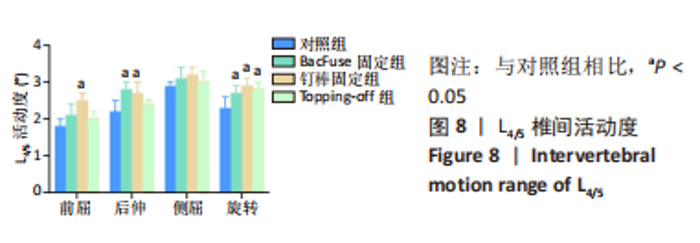
与对照组相比,BacFuse固定组远节邻近节段L4/5在后伸、旋转方向上分别增加27.3%,17.39%(P < 0.05);前屈、侧屈活动未见明显变化。与对照组相比,钉棒固定组的远节邻近节段在前屈、后伸、旋转方向上的活动度均明显增加,分别增加38.89%,22.73%,26.09%(P < 0.05);侧屈活动未见明显变化。与钉棒固定组相比,Topping-off组L4/5节段椎间活动度在前屈方向上减少20%(P < 0.05),后伸、侧屈及旋转未见明显区别。与对照组相比,Topping-off组L4/5节段椎间活动度在旋转方向上增加了21.74%(P < 0.05),前屈、后伸、侧屈及旋转未见明显差异。见图8。"
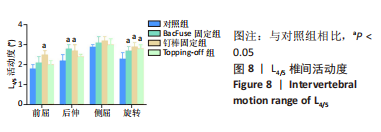
| [1] 唐海,张体栋,陈浩,等. 棘突融合钢板治疗腰椎间盘突出症的临床研究[J]. 中华骨科杂志,2016,36(6):344-352. [2] FALOWSKI SM, MANGAL V, POPE J, et al. Multicenter Retrospective Review of Safety and Efficacy of a Novel Minimally Invasive Lumbar Interspinous Fusion Device. J Pain Res. 2021;14:1525-1531. [3] WANG R, JI X, LIU L, et al. Changes of MRI in inter-spinal distraction fusion for lumbar degenerative disease: A retrospective analysis covering 3 years. J Clin Neurosci. 2020;81:455-461. [4] WEI H, TANG H, ZHANG T, et al. Preliminary efficacy of inter-spinal distraction fusion which is a new technique for lumbar disc herniation. Int Orthop. 2019;43(4):899-907. [5] 陈萌萌,唐海.棘突间装置在腰椎退行性变疾病的相关生物力学研究进展[J]. 国际外科学杂志,2021,48(8):572-576. [6] LIU Z, ZHANG S, LI J, et al. Biomechanical comparison of different interspinous process devices in the treatment of lumbar spinal stenosis: a finite element analysis. BMC Musculoskelet Disord. 2022;23(1):585. [7] 王宝东,侯继春,何人可,等. 国产新型腰椎棘突间撑开器体外生物力学测试及有限元分析[J]. 中国组织工程研究,2020,24(12):1897-1904. [8] BONALDI G. Minimally invasive dynamic stabilization of the degenerated lumbar spine. Neuroimaging Clin N Am. 2010;20(2):229-241. [9] MANFRE L, DE VIVO AE, AL QATAMI H, et al. Successful use of percutaneous interspinous spacers and adjunctive spinoplasty in a 9 year cohort of patients. J Neurointerv Surg. 2020;12(7):673-677. [10] VERHOOF OJ, BRON JL, WAPSTRA FH, et al. High failure rate of the interspinous distraction device (X-Stop) for the treatment of lumbar spinal stenosis caused by degenerative spondylolisthesis. Eur Spine J. 2008; 17(2):188-192. [11] WANG K, ZHU Z, WANG B, et al. Bone resorption during the first year after implantation of a single-segment dynamic interspinous stabilization device and its risk factors. BMC Musculoskelet Disord. 2015;16:117. [12] RAIKAR SV, PATIL AA, PANDEY DK, et al. Inter Spinal Fixation and Stabilization Device for Lumbar Radiculopathy and Back Pain. Cureus. 2021;13(11): e19956. [13] POSTACCHINI F, POSTACCHINI R, MENCHETTI PP, et al. Lumbar Interspinous Process Fixation and Fusion with Stand-Alone Interlaminar Lumbar Instrumented Fusion Implant in Patients with Degenerative Spondylolisthesis Undergoing Decompression for Spinal Stenosis. Asian Spine J. 2016;10(1): 27-37. [14] CUELLAR JM, FIELD JS, BAE HW. Distraction Laminoplasty With Interlaminar Lumbar Instrumented Fusion (ILIF) for Lumbar Stenosis With or Without Grade 1 Spondylolisthesis: Technique and 2-Year Outcomes. Spine (Phila Pa 1976). 2016;41 Suppl 8:S97-S105. [15] SCLAFANI JA, LIANG K, OHNMEISS DD, et al. Clinical outcomes of a polyaxial interspinous fusion system. Int J Spine Surg. 2014;8:35. [16] CHEN M, JIA P, FENG F, et al. A novel minimally invasive technique of inter-spinal distraction fusion surgery for single-level lumbar spinal stenosis in octogenarians: a retrospective cohort study. J Orthop Surg Res. 2022; 17(1):100. [17] KAYE AD, EDINOFF AN, TEMPLE SN, et al. A Comprehensive Review of Novel Interventional Techniques for Chronic Pain: Spinal Stenosis and Degenerative Disc Disease-MILD Percutaneous Image Guided Lumbar Decompression, Vertiflex Interspinous Spacer, MinuteMan G3 Interspinous-Interlaminar Fusion. Adv Ther. 2021;38(9):4628-4645. [18] CHEN M, TANG H, SHAN J, et al. A new interspinous process distraction device BacFuse in the treatment of lumbar spinal stenosis with 5 years follow-up study. Medicine (Baltimore). 2020;99(26):e20925. [19] WILKE HJ, DRUMM J, HAUSSLER K, et al. Biomechanical effect of different lumbar interspinous implants on flexibility and intradiscal pressure. Eur Spine J. 2008;17(8):1049-1056. [20] LINDSEY DP, SWANSON KE, FUCHS P, et al. The effects of an interspinous implant on the kinematics of the instrumented and adjacent levels in the lumbar spine. Spine (Phila Pa 1976). 2003;28(19):2192-2197. [21] GUO Z, LIU G, WANG L, et al. Biomechanical effect of Coflex and X-STOP spacers on the lumbar spine: a finite element analysis. Am J Transl Res. 2022;14(7):5155-5163. [22] BRUSSEE P, HAUTH J, DONK RD, et al. Self-rated evaluation of outcome of the implantation of interspinous process distraction (X-Stop) for neurogenic claudication. Eur Spine J. 2008;17(2):200-203. [23] KARAHALIOS DG, KAIBARA T, PORTER RW, et al. Biomechanics of a lumbar interspinous anchor with anterior lumbar interbody fusion. J Neurosurg Spine. 2010;12(4):372-380. [24] TECHY F, MAGESWARAN P, COLBRUNN RW, et al. Properties of an interspinous fixation device (ISD) in lumbar fusion constructs: a biomechanical study. Spine J. 2013;13(5):572-579. [25] GONZALEZ-BLOHM SA, DOULGERIS JJ, AGHAYEV K, et al. Biomechanical analysis of an interspinous fusion device as a stand-alone and as supplemental fixation to posterior expandable interbody cages in the lumbar spine. J Neurosurg Spine. 2014;20(2):209-219. [26] LEE CH, KIM YE, LEE HJ, et al. Biomechanical effects of hybrid stabilization on the risk of proximal adjacent-segment degeneration following lumbar spinal fusion using an interspinous device or a pedicle screw-based dynamic fixator. J Neurosurg Spine. 2017;27(6):643-649. [27] SHEN H, FOGEL GR, ZHU J, et al. Biomechanical analysis of lumbar fusion with proximal interspinous process device implantation. Int J Numer Method Biomed Eng. 2021;37(8):e3498. [28] KONG C, LU S, HAI Y, et al. Biomechanical effect of interspinous dynamic stabilization adjacent to single-level fusion on range of motion of the transition segment and the adjacent segment. Clin Biomech (Bristol, Avon). 2015;30(4):355-359. [29] 马亮,许永涛,佘远举.腰椎融合联合上一节段棘突间动态固定的有限元分析[J]. 中国组织工程研究,2018,22(23):3647-3653. [30] DEER TR, SAYED D, MALINOWSKI MN, et al. A Review of Emerging Evidence for Utilization of a Percutaneous Interspinous Process Decompression Device to Treat Symptomatic Lumbar Adjacent-Segment Degeneration. Pain Med. 2019;20(Suppl 2):S9-S13. [31] CHEN MM, JIA P, TANG H. Cortical bone trajectory fixation in cemented vertebrae in lumbar degenerative disease: A case report. World J Clin Cases. 2021;9(28):8609-8615. |
| [1] | Lu Jieming, Li Yajing, Du Peijie, Xu Dongqing. Effects of artificial turf versus natural grass on biomechanical performance of the lower limbs in young females during jump-landing [J]. Chinese Journal of Tissue Engineering Research, 2025, 29(6): 1101-1107. |
| [2] | Wang X, Wang Hm, Chen Sh, Feng Tx, Bu Hm, Zhu Lg, Chen Dd, Wei X. Stress and morphological characteristics of intervertebral foramen of cervical rotation-traction manipulation for treating cervical spondylotic radiculopathy: a three-dimensional finite element analysis [J]. Chinese Journal of Tissue Engineering Research, 2025, 29(3): 441-447. |
| [3] | Zhao Yuxin, Liang Liang, Jin Feng, Xu Yangyang, Kang Zhijie, Fang Yuan, He Yujie, Wang Xing, Wang Haiyan, Li Xiaohe. Establishment and stress analysis of a finite element model for adolescent cervical disc herniation [J]. Chinese Journal of Tissue Engineering Research, 2025, 29(3): 448-454. |
| [4] | Li Zhenggang, Shang Xuehong, Wu Zhang, Li Hong, Sun Chaojun, Chen Huadong, Sun Zhe, Yang Yi. Finite element analysis of three internal fixation modalities for treatment of Pauwels type III femoral neck fractures under different loading conditions [J]. Chinese Journal of Tissue Engineering Research, 2025, 29(3): 455-463. |
| [5] | Liu Mengfei, Chen Gang, Shi Yihan, Zeng Lin, Jiang Kan, Yilihamujiang•Wusiman. Finite element analysis of optimization of femoral prosthesis implantation position in unicompartmental knee arthroplasty in osteoporotic patients [J]. Chinese Journal of Tissue Engineering Research, 2025, 29(3): 464-470. |
| [6] | Wang Zilong, Meng Xin, Zhang Zhiqi, Xie Yu, Meng Lingyue, Zhang Qiuxia, Kong Lingyu. Biomechanical characteristics of lower extremities during counter movement jump in male patients with functional ankle instability [J]. Chinese Journal of Tissue Engineering Research, 2025, 29(3): 478-485. |
| [7] | Liang Jiyao, Zhou Honghai, Wei Guikang, Su Shaoting, Chen Longhao, He Xinyu, Liu Liangpu. Quantification of in vivo biomechanics and analysis of influencing factors in cervical spine fixed-point rotation manipulation [J]. Chinese Journal of Tissue Engineering Research, 2025, 29(3): 486-492. |
| [8] | Su Dejun, Dong Wanpeng, Dong Yuefu, Zhang Jichao, Zhang Zhen. Design of asymmetric prosthesis and mechanical analysis of total knee arthroplasty [J]. Chinese Journal of Tissue Engineering Research, 2025, 29(3): 510-516. |
| [9] | Liu Xiaoyin, Zhang Jianqun, Chen Zhen, Liang Simin, Wang Zhiqiang, Ma Zongjun, Ma Rong, Ge Zhaohui. Short-term efficacy of oblique lateral interbody fusion combined with lateral plate fixation in treatment of single-level lumbar degenerative disease [J]. Chinese Journal of Tissue Engineering Research, 2025, 29(3): 531-537. |
| [10] | He Kai, Xing Wenhua, Liu Shengxiang, Bai Xianming, Zhou Chen, Gao Xu, Qiao Yu, He Qiang, Gao Zhiyu, Guo Zhen, Bao Aruhan, Li Chade. Constructing a model of degenerative scoliosis using finite element method: biomechanical analysis in etiology and treatment [J]. Chinese Journal of Tissue Engineering Research, 2025, 29(3): 572-578. |
| [11] | Gao Xilin, Wu Si Zhang Chao Zhu Liguo, Fu Bifeng, Wang Ping. Mechanotransduction proteins in intervertebral disc degeneration [J]. Chinese Journal of Tissue Engineering Research, 2025, 29(3): 579-589. |
| [12] | Shui Xiaoping, Li Chunying, Zhang xin, Li Bin, Feng Chao, Zhou Hongyu, Chen Ke, Liao Yingying. Effects and mechanisms of swimming for inhibiting traumatic joint contracture in a rat model [J]. Chinese Journal of Tissue Engineering Research, 2025, 29(2): 262-268. |
| [13] | Mawulanjiang · Abudurenmu, Zilalai · Julaiti, Baibujiafu · Yelisi, Gulizainu · Yibulayin, Nijiati · Tuerxun. Stress analysis of angled abutments of maxillary central incisor implant crown in different implant spacing [J]. Chinese Journal of Tissue Engineering Research, 2025, 29(16): 3351-3359. |
| [14] | Cao Yilin, Wang Xinyu, Zhuang Yan, Wang Yaru Jiang Zhixiu, Liu Danyu, Men Jiuxu, Ding Yuansheng. Three-dimensional finite element analysis of three-dimensional printed personalized orthodontic appliances for vertical movement of single teeth [J]. Chinese Journal of Tissue Engineering Research, 2025, 29(16): 3360-3368. |
| [15] | Chen Guangneng, Luo Siyang, Wang Mei, Ye Bin, Chen Jiawen, Liu Yin, Zuo Yuwen, He Xianyu, Shen Jiajin, Ma Minxian. Finite element analysis of various root shield thicknesses in maxillary central incisor socket-shield technique [J]. Chinese Journal of Tissue Engineering Research, 2025, 29(10): 2052-2060. |
| Viewed | ||||||
|
Full text |
|
|||||
|
Abstract |
|
|||||
